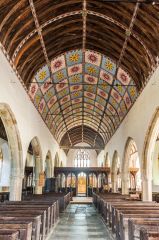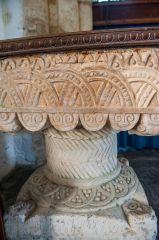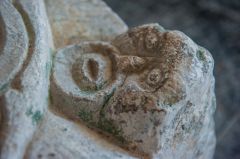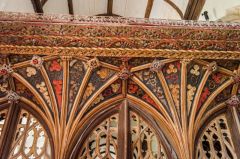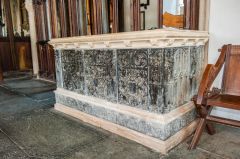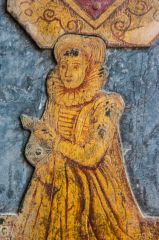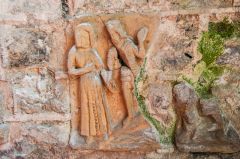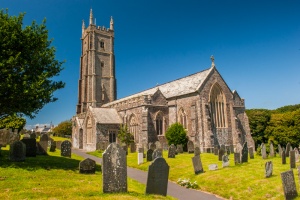
The medieval parish church for Hartland is located, not in Hartland itself, but in the hamlet of Stoke, 2 miles to the west, in the direction of Hartland Quay. The sheer scale of the church, and its striking tower, has given it the nickname 'The Cathedral of North Devon'. It's an apt description, for the tower is a local landmark, easily visible for miles around.
The church was founded near a holy well associated with St Nectan, who lived and was martyred here in the mid-5th century. After Nectan's death the well became a place of pilgrimage, and a monastic community had sprung up by the 6th century. Aerial photographs show boundary walls related to the 6th-century monastery and foundations of buildings to the north of the current church.
The church we see today was begun around 1170 and completely rebuilt in 1360. Its most obvious feature is the eye-catching tower, erected around 1420 and standing 128 feet high. Depending on which source you read it is either the tallest church tower in Devon or the second tallest. More practically, it was used as an aid to navigation by sailors along the treacherous North Devon coast.
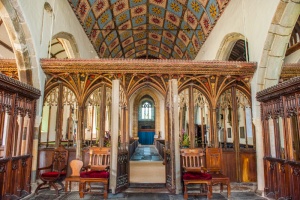
Though the striking tower is St Nectan's most recognisable feature, its what is inside the church that is really worth a visit to see. The church has a beautifully carved 15th-century chancel screen, perfectly preserved, and divided into 11 bays, with painted panels inside each bay.
It is one of the very earliest screens in Devon, dating to around 1450, and easily one of the finest. What makes the screen so fascinating is that each arch is different, in a unique pattern. There was no mass-production here; the woodcarvers created a masterpiece of medieval art, and even today it has the power to awe.
In the chancel is a 14th-century piscina, and at the west end is a late Norman font. There are small faces carved into the underside of the font bowl at each corner, looked down at matching faces on the base.
The upper faces represent baptised parishioners, and they look down on those who are unbaptised. The carvings are marvellous, and there is a handy mirror so you can make them out without contorting your neck too badly!
The pulpit is late medieval, possibly installed at the same time as the screen. The wagon roofs in both the chancel and nave are medieval, but one of the beams comes from the HMS Revenge, a battleship broken up at Appledore.
The church is full of historic memorials, including a small memorial brass in the Stucley Chapel to Anne Abbot dated 1610. Beside the Abbot brass are fragments of carved stone from the Benedictine abbey (now Hartland Abbey house).
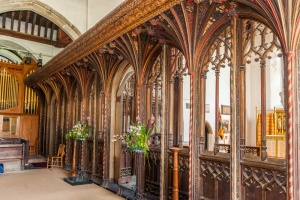
In the chancel is a fascinating altar tomb brought here from Hartland Abbey, where it was being used as a flower trough. The tomb was thought to have held the relics of St Nectan when the Abbey was active, and was moved to the church to serve as the high altar.
Before the tomb, set into the floor, is a brass to Thomas Docton, 1618. Also in the chancel is a chair used by the Ethiopian Emperor Haile Selassie when he officially opened the church fete!
The stained glass windows are worth a closer look; many were inserted by one of the Stucleys of Hartland Abbey, who was fascinated by Arthurian romance. Here you will find a likeness of King Arthur, with Arthurian symbols, and a depiction of King Alfred, who held Hartland in the 9th century. Then there is William the Conqueror, lord of the manor in Norman times.
St Nectan's church is exceptional, a delightful country church in a wonderfully scenic location. It is full of historic interest and well worth a trip to see, especially if you plan on visiting nearby Hartland Abbey.
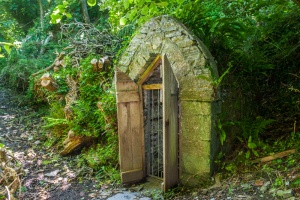
St Nectan of Hartland
Nectan was a 5th-century holy man, a son of King Brychan of Brycheiniog (Brecknock, in Powys, Wales). Nectan was inspired by the story of St Anthony, and determined to emulate his way of life. Nectan sailed from Wales, vowing to settle wherever his boat chanced to land. It came ashore in North Devon and Nectan settled here with his followers. Nectan's cow was stolen, and when he tried to convert the thieves to Christianity they cut off his head.
St Nectan's Holy Well
According to the earliest written record, Nectan then picked up his head and carried it to his well, where he died. One of the thieves was so filled with awe and remorse that he buried him by the well. Miracles were reported at his tomb, and St Nectan's Well became a place of pilgrimage.
You can find the well just 300 yards from the lych gate leading to the churchyard. A short path off the main road to Hartland leads you to a small, wooded dell, where a stone well-head protects the spring.
The well itself is protected by an iron gate, but you can see into the chamber quite easily, and even scoop up a handful of the water if you're so inclined (I tried; its very cool, but I didn't dare to drink it).
About St Nectan's Church, Hartland
Address: Stoke Road,
Hartland,
Devon,
England, EX39 6DU
Attraction Type: Historic Church
Location
map
OS: SS235246
Photo Credit: David Ross and Britain Express
HERITAGE
 We've 'tagged' this attraction information to help you find related historic attractions and learn more about major time periods mentioned.
We've 'tagged' this attraction information to help you find related historic attractions and learn more about major time periods mentioned.
Find other attractions tagged with:
NEARBY HISTORIC ATTRACTIONS
Heritage Rated from 1- 5 (low to exceptional) on historic interest
Hartland Abbey - 0.3 miles (Historic House) ![]()
Hartland Quay - 0.8 miles (Countryside) ![]()
Spekes Mill Mouth Waterfall - 0.9 miles (Countryside) ![]()
Docton Mill Gardens - 1.2 miles (Garden) ![]()
Clovelly, All Saints Church - 4.6 miles (Historic Church) ![]()
Clovelly Court Gardens - 4.6 miles (Garden) ![]()
Morwenstow, St John's Holy Well - 6.1 miles (Prehistoric Site) ![]()
Morwenstow, St John's Church - 6.2 miles (Historic Church) ![]()
Nearest Holiday Cottages to St Nectan's Church, Hartland:
More self catering near St Nectan's Church, Hartland
